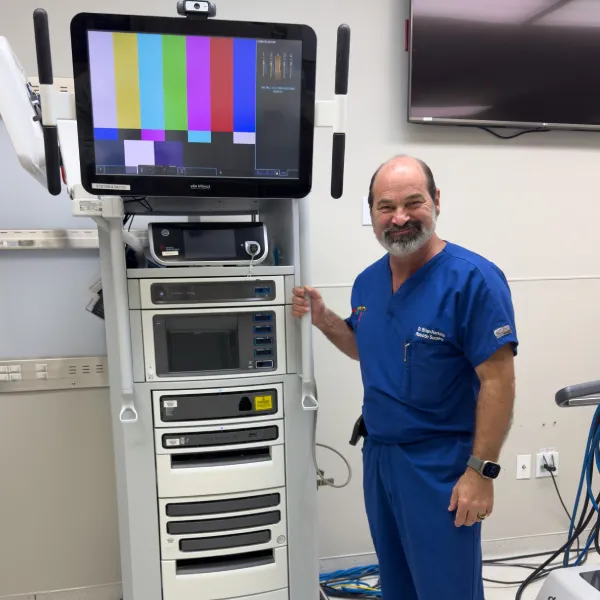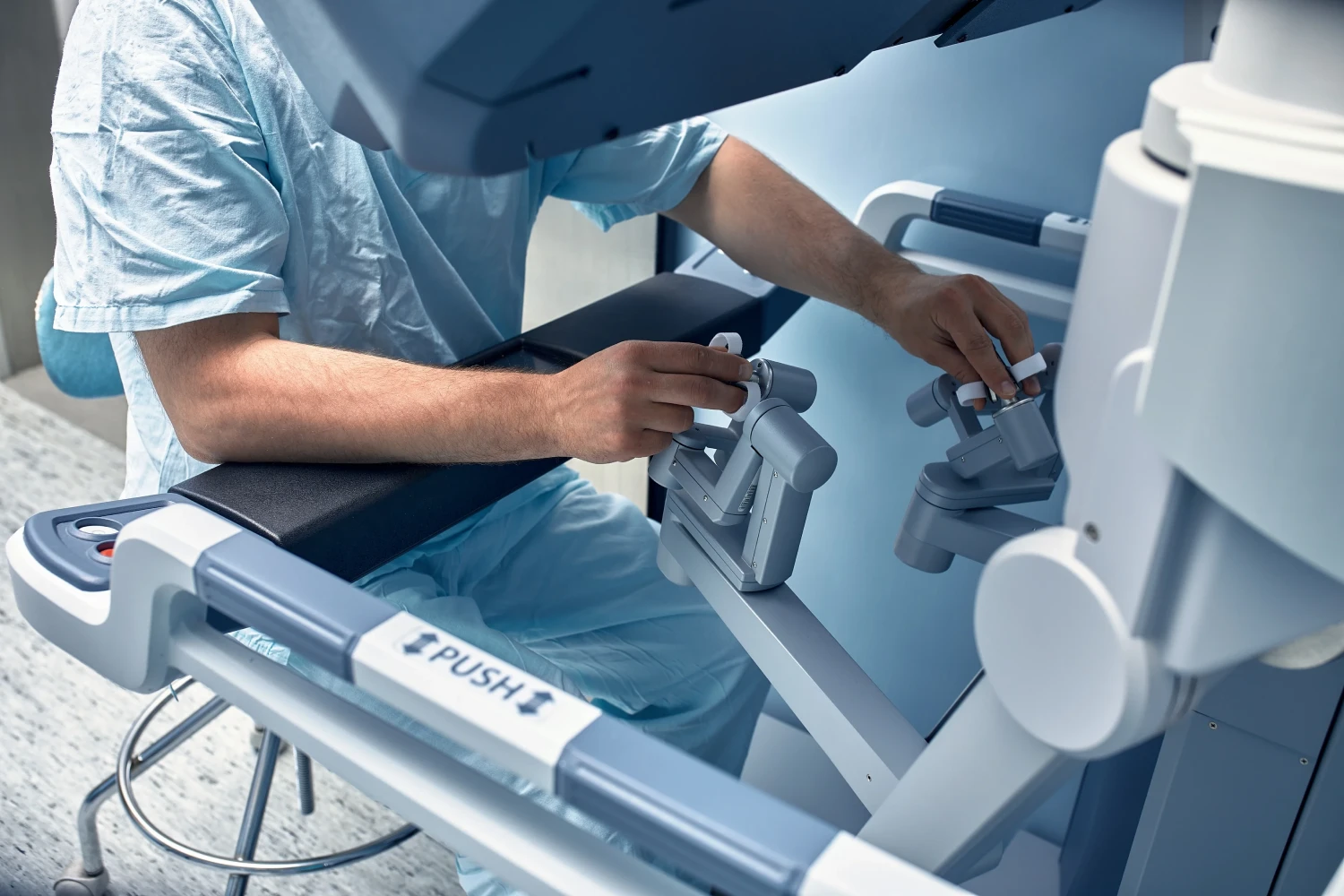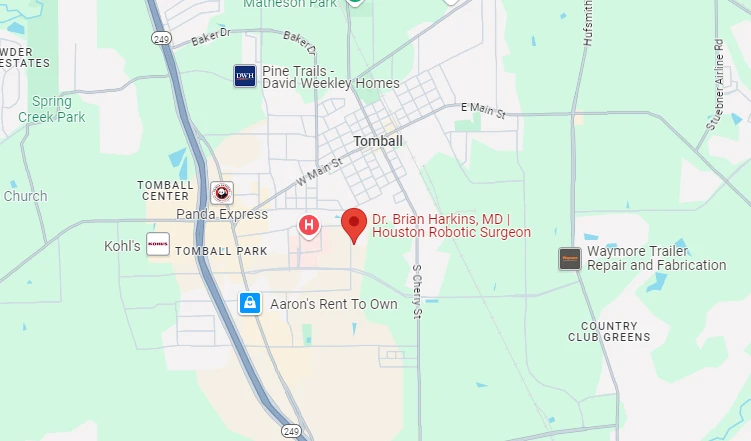
If you’re wondering how long does it take to recover from a robotic hernia surgery in Houston, TX?, you’re not alone. This advanced surgical option offers a minimally invasive way to repair various hernias—whether inguinal, ventral, or hiatal. Thanks to small incisions and the use of lightweight hernia mesh, most Greater Houston Area patients go home the same day. However, tissue healing takes time, and full recovery—meaning no restrictions on activities like heavy lifting—typically takes 4 to 6 weeks.
This comprehensive guide walks you through every phase of hernia surgery recovery, highlights how Houston’s humidity can affect swelling, and explains why robotic surgical techniques usually mean less pain compared to traditional open surgery. Your overall health, the type of hernia you have, and your job’s physical demands all influence your specific recovery timeline.
Instead of the long incision used in traditional open hernia repair, robotic-assisted hernia techniques create three or four 8-mm ports in the abdomen. The articulated instruments move like a human wrist but with sub-millimeter accuracy, letting the surgeon perform a meticulous repair that is often less invasive than traditional approaches.
Robotic technology avoids wide dissection of the abdominal muscles and nerves. Less trauma equals less post-operative pain and fewer narcotics.
With tinier wounds, there is less surface area for bacteria—a perk when Houston humidity is high.
A 3D camera magnifies each fiber, allowing the surgeon to repair the hernia with evenly distributed tension. A balanced closure means lower recurrence and earlier return to activity.
| Week | What You Feel | Allowed Activities | Restrictions |
| 0–1 | Mild soreness, bloating, fatigue | Short indoor walks, deep-breathing | No lifting >10 lbs, no driving if on narcotics |
| 1–2 | Energy boost; incision itching | Light chores, desk work | Avoid pools, heavy core moves |
| 2–3 | Minimal pain, swelling resolves | Full office hours, stationary biking | Lift cap at 20 lbs; no HIIT |
| 3–4 | Near pain-free; strength returning | Light jogging, yoga, 35-lb lifting | No deadlifts or contact sports yet |
| 4–6 | Full range of motion | Heavy labor, competitive sports once cleared | None after MD approval |
While 4–6 weeks is the average window, several variables unique to you—or to Houston—can push recovery faster or slower. Understanding these helps you set realistic goals and avoid setbacks.
Proper home care bridges the gap between the operating room and full Houston life. Follow this day-by-day playbook to keep swelling down, pain under control, and your mind at ease.
Even smooth recoveries can throw curveballs. Recognize early warning signs so a small hiccup doesn’t become a hospital readmission.
Most practices keep an on-call surgeon. Text or call rather than waiting; early antibiotics or imaging can prevent major complications.
The moment you feel ready to merge onto I-45 or jog Buffalo Bayou Trail, confirm the timing aligns with tissue biology—then layer in weather smarts and ergonomic tweaks.
Recovering from robotic hernia repair in Houston usually spans 4–6 weeks, but smart pacing, climate awareness, and follow-up with a trusted hernia specialist will help you reclaim life faster and stronger than ever. If questions arise, contact your surgical team—they’re your best ally in reducing the risk of complications and ensuring long-term success.
Recovery after robotic hernia surgery generally spans 4 to 6 weeks. This timeline allows tissues to heal fully, after which most patients can resume strenuous activities without restrictions. Your exact recovery depends on factors such as your overall health, the type of hernia, and your daily physical demands.
Repair surgery through robotic surgical techniques offers a minimally invasive alternative to traditional open surgery. While open hernia surgery requires a larger incision and longer recovery, robotic surgery uses small ports and precise instruments to reduce pain and hospital stay. The choice depends on the type and size of the hernia.
Laparoscopic inguinal hernia repair and houston robotic hernia surgery are both minimally invasive procedures that use small incisions, resulting in less pain and faster recovery compared to traditional hernia repairs. Robotic techniques provide enhanced precision, often leading to gentler fixes—but is robotic surgery better? Many surgeons believe it improves outcomes depending on the type of hernia.
A patient may need hernia surgery if the hernia causes significant discomfort or complications like obstruction. Hernia repair surgery typically involves making an incision near the hernia site to push back the protruding tissue and reinforce the weakened abdominal wall. This may include the use of new Phasix™ mesh to strengthen the repair.
Traditional open surgery requires a larger incision and directly exposes the hernia, while minimally invasive surgery uses smaller incisions and specialized instruments. The minimally invasive approach, including robotic surgical techniques or laparoscopic surgery, often results in less hernia repair pain, shorter hospital stay, and quicker return to daily activities.
The new Phasix™ mesh is a bioabsorbable material designed to provide temporary support to the abdominal wall while encouraging natural tissue regeneration. It reduces long-term complications and may lower the risk of hernia recurrence compared to permanent synthetic meshes, enhancing the success of both surgical repair and minimally invasive procedures.
The length of stay in the hospital after hernia repair depends on the surgical approach. Patients undergoing open hernia surgery or complex abdominal surgery may require longer observation, while those having laparoscopic surgery or Houston robotic hernia surgery typically go home the same day or within 24 hours, reflecting the benefits of minimally invasive techniques.
Yes, there are various types of hernias, including inguinal, umbilical, ventral, and hiatal hernias. The type of hernia significantly influences the choice of surgical procedure. For instance, inguinal hernia repair often uses laparoscopic or robotic techniques, while some larger or recurrent hernias may require traditional open surgery or tailored repair methods.
Robotic surgical techniques enhance the surgeon’s ability to perform meticulous repairs with 3D visualization and greater dexterity. This allows for a more balanced closure of the defect, potentially reducing hernia repair pain, minimizing tissue trauma, and decreasing the likelihood of hernia recurrence compared to conventional methods.
For houston patients, recovery after hernia surgery depends on the type of surgery and individual health factors. Procedures using robotic surgery or laparoscopic inguinal hernia repair typically offer faster recovery, less pain, and smaller incisions compared to traditional hernia repairs. Effective post-operative care and avoiding strenuous activities are key to successful healing.




Dr. Brian Harkins is a renowned surgeon specializing in advanced, minimally invasive, and robotic surgical techniques. With a dedication to innovation and personalized patient care, he has transformed countless lives by delivering exceptional outcomes.

I want a website like this, where do i start?